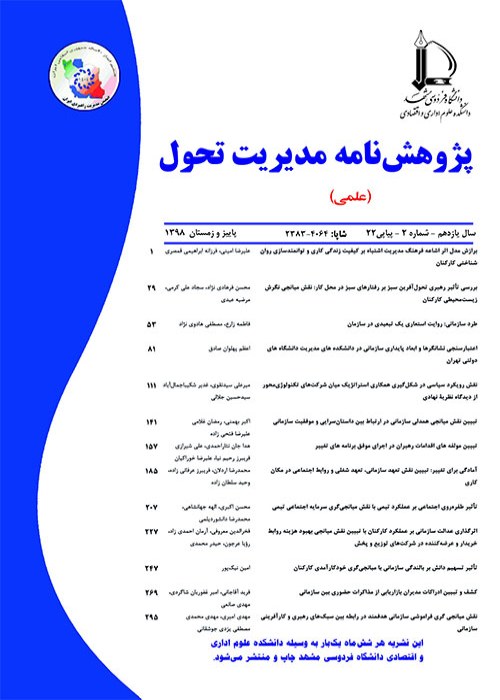Developing a Model for Organizational Health A study on Isfahan’s Mobarakeh Steel Company
Organizational health, as the ability to operate successfully in complex conditions, is one of the main concerns of organizations. this concept has many components encompassing a wide range of organizational capabilities that affect the survival, growth, and performance of the organization. the main focus of organizational health is on evaluating and identifying strengths and weaknesses from a holistic perspective and improving them appropriately. therefore, it is important to pay attention to different influential perspectives on the organization, especially the views of the organization's key stakeholders. this is also important for isfahan's mobarakeh steel company as a large steelmaker with a wide range of different stakeholders. this study was to answer the key question by examining the organizational health phenomena from the key stakeholders' point of view: "what are the key factors of organizational health for isfahan's mobarakeh steel company?"
The concept of organizational health first introduced in 1964 is encompassed a wide range of organizational capabilities, depending on the theoretical origin, type of organization, and dominant context. also, a healthy organization is one with all its components working well and capable of doing what is expected of the mission and managing the various affecting factors. one of the most important reasons for studying the concept of organizational health is its potential impacts on performance aspects of the organization. organizational performance encompasses a wide range of tangible and intangible aspects.
This research is an applied study in terms of purpose, and in terms of method, it is a systematic grounded theory. purposive sampling was used to select and study key stakeholders until reaching theoretical saturation. data were collected through interviews and analyzed using atlas. ti 8 software. during open coding, 1532 citations were identified and summarized in 104 open codes. after axial coding, they were categorized in 37 axial categories: pivotal phenomenon, strategies, causal, contextual, interfering factors, and results. then, through the outcomes of selective coding, it was proposed the paradigmatic model of organizational health from the perspective of key stakeholders. the validity of the model was confirmed by qualitative and quantitative indices of cvi and cvr, using the opinions of an 8-expert panel, and its reliability was confirmed by qualitative and quantitative retest reliability methods.
According to the findings, the pivotal phenomenon of organizational health from the perspective of key stakeholders of the company includes three main aspects of acting on organizational responsibilities in different areas such as social, environmental, and ethical, creating a balanced and sustainable image and performance, agility, and flexibility in dealing with confronted issues and high productivity of the resources available to the organization. causal factors of organizational health include correct organizational leadership at different stages with participation of employees, employee competence, structure and processes tailored to the organization's goals, job enrichment, efforts to understand and respond effectively to customer expectations, good communication with suppliers, and proper performance of suppliers. strategies for promoting organizational health include recruitment, development, and promotion of employees on the basis of competence and performance, effective care, support and retention of staff, selection and development of leaders based on competence and performance, leadership participation in staff development, use of knowledge and experiences of stakeholders, innovation and technology advancement, focusing on creating the future, promoting strategic and systematic thinking, making effective use of the ict, improving the culture of the organization and stakeholders, and continually improving supply and purchase practices. contextual factors that influence the success of organizational health promotion strategies include commitment, attitude and independence of leaders, organizational culture and climate, communication, employee retention and development, supplier selection and management, structure, processes, and systems integrity, knowledge, technology, and innovation management, the organization's target setting system, the variety of customer services and enterprise investments. interfering factors, that influence the impact of strategies on organizational health outcomes, include national and global economic and financial issues, government, national and local legal institutions performance, political, cultural, and social issues, and the competitive and technological environment of business. results of maintaining and promoting organizational health for the company include performance and value creation of the company for different stakeholders, promotion of the organization's brand, and improvement of the experience of different stakeholders and safety, health, and professional growth of the employees.
This research has attempted to have a more comprehensive view of the health of the organization and its causal factors, strategies, intervening factors, and results for isfahan's mobarakeh steel company. by comparing the findings with the literature, it can be seen that the categories extracted, in addition to those mentioned in previous research, including new ones such as ict, technology, expectations of customers and suppliers, investments of the organization, etc that are also in the domain of management but outside the scope of organizational behavior. also, due to the view type of this study, its results can be used to prepare a roadmap to improve the set of health affecting factors. it is also suggested to other researchers to consider the identified dimensions and components in future research and to use the findings of the current research to develop standardized measurement tools.
- حق عضویت دریافتی صرف حمایت از نشریات عضو و نگهداری، تکمیل و توسعه مگیران میشود.
- پرداخت حق اشتراک و دانلود مقالات اجازه بازنشر آن در سایر رسانههای چاپی و دیجیتال را به کاربر نمیدهد.


